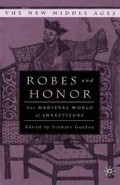Abstract
Rather than broad theory that seeks to explains all investiture in all settings, I propose a “middle range” hypothesis specific to the investiture tradition that began in Central Asia; it seeks to explain some of the major questions that arise from our essays: Why did this tradition survive in a recognizable form for almost two thousand years in spite of vast changes in governmental structure? Why did it spread across much of Asia, some of Europe, and parts of Africa? How did it find usage in Christianity, Islam, Buddhism, Judaism, Confucianism, Hinduism, and various “barbarian” settings from Russia to sub-Saharan Africa? How is it that a tremendous variety of people received robes, such as particularly adept court dancers, sons of kings, diplomatic envoys, military commanders, nuns, and Sufi holy men? How is it that robing sometimes meant promotion and sometimes signaled defeat? How is it that robes sometimes honored single individuals and other times whole groups, such as all of the leaders going on a campaign? How is it that kings were sometimes robed by a high clergyman and other times they robed themselves? Why was the robing ceremony sometimes so simple as to be nonverbal, and other times included oaths and even written contracts? Why was the robe in some settings accompanied by items of real wealth—gold, silver, jewels—and other times not?
Access this chapter
Tax calculation will be finalised at checkout
Purchases are for personal use only
Preview
Unable to display preview. Download preview PDF.
Notes
Some fabulous robes became part of a circulation of “wonderful objects” in a broad region that stretched at least from the Middle East to India and onward to China as early as the eleventh century. Great kings sent presents to each other (as marks of the greatness of the giver and the receiver) that included objects made in their workshops, war booty, items received as gift or tribute, purchased curiosities, and items of alleged antiquity. We have glimpses of this circulation in various courtly accounts, but the overall pattern has yet to be worked out. See Oleg Grabar, “The Shared Culture of Objects,” in Henry Maguire, ed., Byzantine Court Culture from 829 to 1204 (Washington, DC: Dumbarton Oaks, 1997), pp. 115–30.
See the autobiography of a low-level mansabdar who served in Bengal in the early decades of the seventeenth century, Baharistan-I-Ghaybi, trans. M. I. Borah (Gauhati, Assam: Government of Assam, 1936), pp. 75–113. Mughal rulers for more than one hundred years resisted the elite becoming “landed”: Two methods were to separate mansabdars from their estates by requiring that they serve in some distant area and nominally sequestering estates at death. Placing mansabdars far away and jeopardizing heritability made fealty ceremonies and practices particularly critical.
Editor information
Copyright information
© 2001 Stewart Gordon
About this chapter
Cite this chapter
Gordon, S. (2001). Robes, Kings, and Semiotic Ambiguity. In: Gordon, S. (eds) Robes and Honor. The New Middle Ages. Palgrave Macmillan, New York. https://doi.org/10.1007/978-1-349-61845-3_18
Download citation
DOI: https://doi.org/10.1007/978-1-349-61845-3_18
Publisher Name: Palgrave Macmillan, New York
Print ISBN: 978-1-349-61847-7
Online ISBN: 978-1-349-61845-3
eBook Packages: Palgrave History CollectionHistory (R0)

